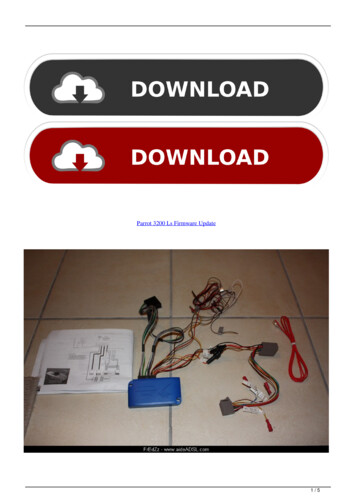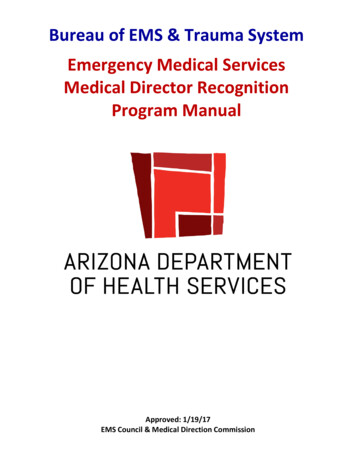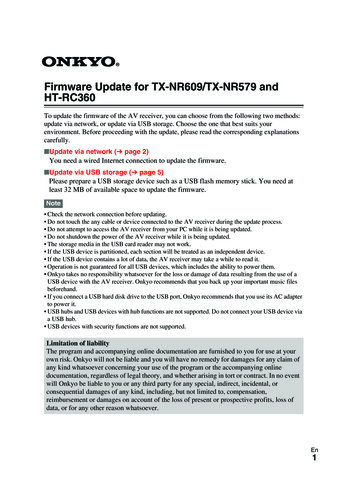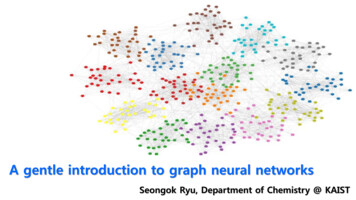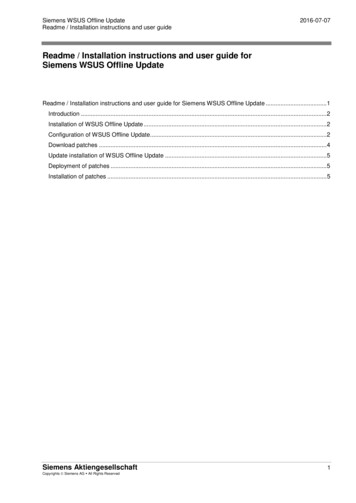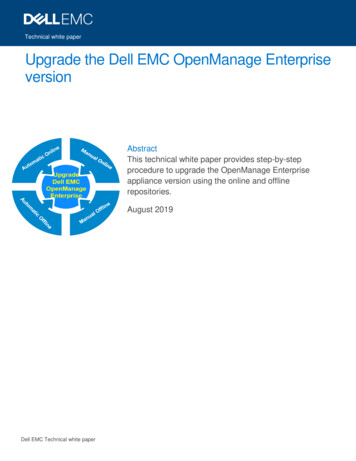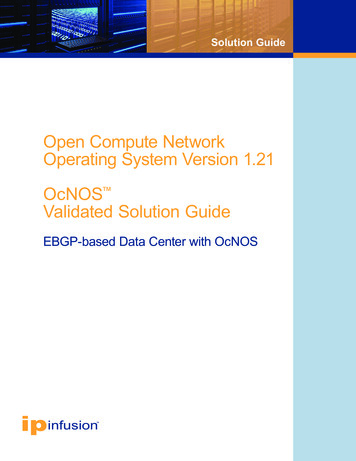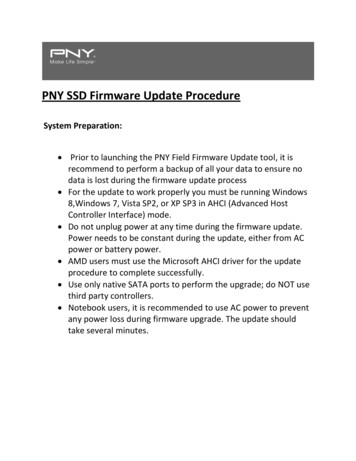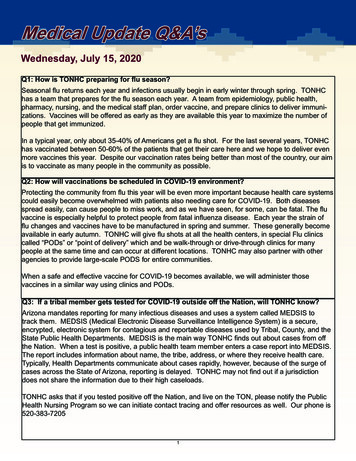
Transcription
Medical Update Q&A’sWednesday, July 15, 2020Q1: How is TONHC preparing for flu season?Seasonal flu returns each year and infections usually begin in early winter through spring. TONHChas a team that prepares for the flu season each year. A team from epidemiology, public health,pharmacy, nursing, and the medical staff plan, order vaccine, and prepare clinics to deliver immunizations. Vaccines will be offered as early as they are available this year to maximize the number ofpeople that get immunized.In a typical year, only about 35-40% of Americans get a flu shot. For the last several years, TONHChas vaccinated between 50-60% of the patients that get their care here and we hope to deliver evenmore vaccines this year. Despite our vaccination rates being better than most of the country, our aimis to vaccinate as many people in the community as possible.Q2: How will vaccinations be scheduled in COVID-19 environment?Protecting the community from flu this year will be even more important because health care systemscould easily become overwhelmed with patients also needing care for COVID-19. Both diseasesspread easily, can cause people to miss work, and as we have seen, for some, can be fatal. The fluvaccine is especially helpful to protect people from fatal influenza disease. Each year the strain offlu changes and vaccines have to be manufactured in spring and summer. These generally becomeavailable in early autumn. TONHC will give flu shots at all the health centers, in special Flu clinicscalled “PODs” or “point of delivery” which and be walk-through or drive-through clinics for manypeople at the same time and can occur at different locations. TONHC may also partner with otheragencies to provide large-scale PODS for entire communities.When a safe and effective vaccine for COVID-19 becomes available, we will administer thosevaccines in a similar way using clinics and PODs.Q3: If a tribal member gets tested for COVID-19 outside off the Nation, will TONHC know?Arizona mandates reporting for many infectious diseases and uses a system called MEDSIS totrack them. MEDSIS (Medical Electronic Disease Surveillance Intelligence System) is a secure,encrypted, electronic system for contagious and reportable diseases used by Tribal, County, and theState Public Health Departments. MEDSIS is the main way TONHC finds out about cases from offthe Nation. When a test is positive, a public health team member enters a case report into MEDSIS.The report includes information about name, the tribe, address, or where they receive health care.Typically, Health Departments communicate about cases rapidly, however, because of the surge ofcases across the State of Arizona, reporting is delayed. TONHC may not find out if a jurisdictiondoes not share the information due to their high caseloads.TONHC asks that if you tested positive off the Nation, and live on the TON, please notify the PublicHealth Nursing Program so we can initiate contact tracing and offer resources as well. Our phone is520-383-72051
Medical Update Q&A’sQ4: Why is there a delay in testing at TONHC?Testing appointments at TONHC have been getting filled on a daily basis and the appointment linesare also busy as well. This is to be expected when there is a rise in cases, not only for the Nation, butPima County and Arizona as a whole.TONHC is asking patients to be tested between 5 to 14 days after a known or suspected exposure.Testing too soon can result in a false negative test. This means the test result was negative, but theperson really was infected. It was just too early to detect on the test.Q5: Are resources offered to families in isolation or quarantine?Yes. When patients test positive for COVID-19, a nurse will conduct an interview and offer resourcesto families. TONHC works with Unified Command to get resources delivered to the homes of familiesin quarantine. Food, drinks, and household cleaning supplies are offered.If a person who tests positive off the Nation, TONHC may not be aware of the case. If you areneeding resources, please call TONHC Public Health Nursing office at 383-7205 to make the request.Q6: A community member was exposed to someone who tested positive for the COVID-19.What should she do? Should she get tested? Should her children get tested?Feeling like you just got exposed can be scary. Having information about what to do to protectyourself and family is important. Guidance about exposure and testing has several parts:1. QuarantineWhen a person thinks they might have been exposed, the most important action to take is stayingaway from other people. This is what we call quarantine, it keeps an exposed person with potentialinfection away from others for the time it takes for symptoms to start. For COVID-19, it takes up to 14days to show symptoms. Many people to not start self-quarantine and spread virus to others duringthis time. This is what we need to re-enforce with our families and community.2. Exposure risk assessmentExposure to COVID-19 means different things to different people.COVID-19 mostly spreads through the drops of saliva and mucus from our breath, mouth, and nose.The farther you stay away from another person’s breath, saliva, and nose droplets, the safer you willbe. High-risk direct contact usually means getting coughed or sneezed on by someone sick withCOVID-19.Health teams determine the risk from a possible exposure by asking about:1. Distance: How close were you? More than 6 feet away?2. Duration: How long did you spend time close together? Less than 10-15 minutes?3. Protection and barriers: Were you and the other person wearing a masks at all times? Wasthere a physical barrier between you?If you were at least 6 feet apart, spent less than 10-15 minutes together, and people were wearingmasks, then the risk of getting is very low.While can’t control if someone around us has COVID-19, we can control how close we get to otherpeople, we can choose to wear a mask, and we can make sure we aren’t close to people for morethan a few minutes.2
Medical Update Q&A’sTestingIf the exposure was enough to worry about getting infected or a person has risk factors that couldmake them sick, now is the time to consider testing. The most important control measure is not thetest result itself, but the actions you take while waiting to get tested or waiting for results. Peopleneed to start quarantine immediately after a concern of exposure. To get the most accurate results,testing for COVID-19 should occur between 5 and 14 days after an exposure. Before 5 days, the testresults might not detect the virus.To get tested, most people will go through their healthcare provider. Some people go to pharmacies,state and county testing sites, and other commercial locations who will test for different reasons. Formost testing, patients will be asked screening questions and set up an appointment. Because of thelarge numbers of tests being requested there ae often long wait times for appointment and results.While this can be frustrating, the test result is not as important as staying in quarantine.At this time, most tests are nasal swabs that look for virus RNA. There are many brands of tests fromdifferent commercial laboratories. There also are blood tests that check for antibodies that usuallymeans the infection occurred more than 2 weeks ago.Guidance after these test results can be complicated reviewing a test result with a health careprovider can help.So, in this case, the community member’s exposure risk should be assessed. If the person was notcloser than 6 feet, she and the person with COVID-19 were wearing their masks, and they spentless than 15 minutes together, the risk of infection is low and we provide reassurance. If there wasa close, unmasked exposure longer than 15 minutes, we would recommend quarantine and testing5-14 days after the day of exposure. If the test is positive, the next step would be start contacttracing of her children and other close contacts to decide their risks and need for testing.Some websites with accurate, fact-checked information ebcms.pima.gov/cms/One.aspx?portalId 169&pageId sease-2019www.AZDHS.govPlease call the TONHC clinics if you think you might have been exposed. Sells: 520-383-7209San Xavier: 520-295-2529 or 520-295-2590 San Simon: 520-362-7078 TONHC Public Health nursing: 520-383-72053
Medical Update Q&A’sQ7: Should people get re-tested after they get better?Many people ask about re-testing or tell us their work place requires a negative test to return.In most cases, public health teams do not recommend re-testing. Many people, even if fullyrecovered, will test positive for several weeks after infection due to presumed “dead virus RNA”lingering in the nose. Most people who have recovered have a low likelihood of being contagiousto others. Current recommendations include that a person with a positive re-test result will need toisolate for an additional 10 days. TONHC has been re-testing people before returning to their usualdialysis location and special circumstances to minimize the chance of spread to highly vulnerablegroups where many people are together. If employers require re-testing, this can be performedthrough their occupational health company.TONHC teams can help answer specific questions and provide a note to return to work.Q8: Intensive Care Unit beds are becoming scarce and some Arizona patients have been ormay be transported out of state to Albuquerque, Las Vegas, and Los Angeles. What is thepossibility of Tohono O’odham Nation members being in this situation?We are all worried about hospital bed shortages. One response implemented at the State levelacross Arizona is the COVID-19 Surge Line. Doctors who need to admit a patient with COVID-19to a hospital now call the Surge Line. The Surge Line has updated information about what hospitalshave available beds including intensive care beds. This provides a more efficient and timely processto get sick patients to a hospital that has resources for them.Arizona has also shared documents that describe “Crisis Standards of Care.” This allows hospitalsflexibility to share and spread resources, staff, and hospital beds. Additionally, it provides guidance incase hospitals get overwhelmed with patients.Q8: Where is the epi-center of positive cases on the Nation?The first case of COVID-19 diagnosed in a member of the Tohono O’odham Nation occurred in midMarch. Initially, most of the cases were identified from Tucson area residents. Since then, about halfof all cases and then gradually on the Nation’s reservation. By July, half of the cases among tribalmembers were being identified in persons who resided on the reservation.The drive through testing last week resulted in 17 positive cases. For some, the expectation mayhave been there would be significant increase from the drive through testing, which for last weekdrive through testing, that may have not been the case. We understand the current positive casereport is 361 with 148 on the Nation. If this is the case, where is the epi-center so to speak on ourNation? You mentioned social gatherings as a place of infection as well as family visiting one another,etc. Are these two examples, the primary infection source? For the listening audience, what are moreexamples you can provide, if any, to share with Nation members.Cases are spread throughout the Tohono O’odham Nation. Gatherings with people outside of thehousehold has been one of the many way our cases are rapidly spreading. With the most recentExecutive Order #2020-08, with the exception of persons residing in the same household, all socialgatherings are hereby prohibited until further notice. “Social gatherings” shall include all events andactivities held for social and/or community purposes. Religious services and traditional ceremoniesare not considered social gatherings, however, any activities held in association with a religiousservices or ceremony for social purposes (i.e. gathering before/after for eating, drinking, dancing,socializing, etc.) are prohibited.4
Medical Update Q&A’sQ9: Are people still allowed to get non-COVID related surgeries? How is the decision made?If I need surgery I previously asked about non-COVID related surgeries. The Governor’s May 15thstate reopening allowed for certain surgeries to occur, pending COVID-19 testing of patient. Theresponse from TONHC representative calling in for Dr. Villar was that comes from the state. I’masking again for Nation members who may be in this situation who may require Non-COVID-19surgeries may be required. Who is monitoring this issue?Q10: If people hear or read about a pending social gathering and there are concerns withpossible exposure and infection, is the first contact to TOPD, EOC, TONHC, or the District?Thank you.The first contact should be to the District. The District should discourage any gatherings as specifiedin the executive order. If the gathering does take place then TOPD should be called.The language in the current executive order “prohibits” gatherings, the new legislative action allowsTOPD to cite for any violations of the executive order if they are unsuccessful in getting complianceby warning the group that they are in violation of a current executive order.Q11: What can a community do when a person is not behaving according to the ordinances?Examples we have seen are a vehicle driving around in our community & parked in the road drivergot down & walked around. Music was loud but lowered down as he walked around his vehicle aftercurfew. Can TOPD stop any of them? Sometimes it’s a nuisance and some people still need to work.Are they fined? How many have been stopped and issued tickets?Please call TOPD and provide as much information as possible to address the concern.Q12: Are COVID-19 self-test kits available and reliable?Because COVID-19 is a public health emergency, the U.S. Food and Drug Administration (FDA)issued an Emergency Use Authorization for COVID-19 testing. The tests are new and not all havebeen well studied. Before laboratories use a new test on samples from patients, they must verify thetest performance (make sure it works as expected) using “positive” and “negative” control materials.The positive control should always test positive, and the negative control should always test negative.Two types of tests are generally available:Genetic material (RNA) from the virus (nose swabs) use for current infection.Serology (antibody blood test) to check for a person’s immune system’s response to past infection.TONHC currently uses mostly specimens from nasal swabs that test for genetic material (RNA) fromthe COVID-19. The test TONHC uses at our clinics usually provides results within an hour as longas the lab staff does not get too many tests at one time. We also send specimens to specializedlaboratories, but results can take up to a week to be available.Some commercial labs offer home and self-test kits. This allows a person to use a nasal swab intheir own nose and send the specimen by mail to a lab for testing. Results usually take 4-7 days.“Pooled testing” is another strategy that can help in testing large numbers of people. Swabs aretaken from groups of 5-10 people and tested in a single batch. If the group test is positive, then eachindividual is tested to see who was infected. This allows labs to be more efficient and test morepeople by using fewer resources.5
Medical Update Q&A’sQ13: Will a drive-thru test be done in the northern part of the Nation?TONHC has provided two Drive-Thru testing clinics and will use this tool for testing large numbersof people rapidly when there is a concern for cluster outbreaks. The second drive-thru tested 316people in 7 hours. Over 50 staff were needed to hold the event including support from the ArizonaNational Guard. Testing large numbers of people after a concerning event can be very useful butrequired a large amount of resources and staff. To conduct more Drive-thru testing, the Nation willneed outside support.6
may be transported out of state to Albuquerque, Las Vegas, and Los Angeles. What is the . possibility of Tohono O'odham Nation members being in this situation? We are all worried about hospital bed shortages. One response implemented at the State level . across Arizona is the COVID-19 Surge Line. Doctors who need to admit a patient with COVID-19
